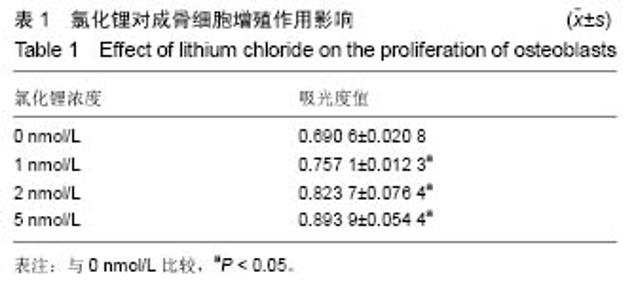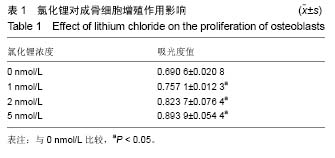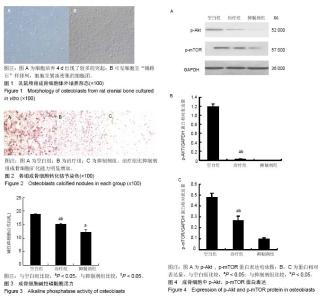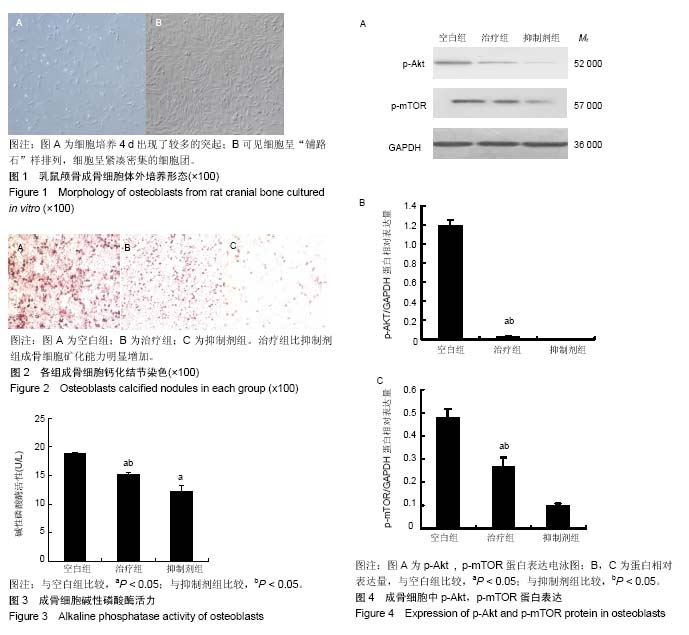Chinese Journal of Tissue Engineering Research ›› 2019, Vol. 23 ›› Issue (19): 3002-3006.doi: 10.3969/j.issn.2095-4344.1246
Previous Articles Next Articles
Effect of lithium chloride on AKT-mTOR signal pathway in osteoblasts after estrogen receptor inhibition
Xu Yier1, Sun Guicai2, Chen Shuilin2, Fan Xiangwei2
- (1Technology Center of Harbin Pharmaceutical Group Co., Ltd., Harbin 150000, Heilongjiang Province, China; 2Department of Orthopedics, the Fourth Affiliated Hospital of Nanchang University, Nanchang 330003, Jiangxi Province, China)
-
Received:2019-01-20Online:2019-07-08Published:2019-07-08 -
Contact:Sun Guicai, MD, Chief physician, Department of Orthopedics, the Fourth Affiliated Hospital of Nanchang University, Nanchang 330003, Jiangxi Province, China -
About author:Xu Yier, Master, Researcher, Technology Center of Harbin Pharmaceutical Group Co., Ltd., Harbin 150000, Heilongjiang Province, China -
Supported by:the National Natural Science Foundation of China, No. 81473503 (to SGC)
CLC Number:
Cite this article
Xu Yier1, Sun Guicai2, Chen Shuilin2, Fan Xiangwei2 . Effect of lithium chloride on AKT-mTOR signal pathway in osteoblasts after estrogen receptor inhibition[J]. Chinese Journal of Tissue Engineering Research, 2019, 23(19): 3002-3006.
share this article

2.1 细胞形态 倒置显微镜观察:细胞接种24 h后进行显微镜观察,发现其部分细胞出现了贴壁的情况,且部分细胞出现了伸展的情况。很多细胞(培养4 d)出现了较多突起的情况,见图1A。部分细胞(培养7-10 d)为单层细胞,且细胞形态多样,大多呈现单核、三角形、梭形以及多边形等,有较多突起,呈“铺路石”样排列,细胞紧凑密集的细胞团见图1B。符合成骨细胞特点。 2.2 氯化锂对成骨细胞的增殖作用 见表1。CCK-8法检测结果显示,不同浓度的氯化锂都能对成骨细胞增殖产生不同程度作用,生长率随着氯化锂的浓度升高而增加,在 0-5 nmol/L内具有有线性关系。其余各组与0 nmol/L比较差异有显著性意义(P < 0.05)。"


2.3 茜素红染色结果 汇合时的细胞大多呈现出多层重叠生长的情况,局部细胞会堆集成灶状,对钙结节采取茜素红染色,将其染成橘红色,结果均表明此方法所得细胞均具有生物学以及成骨细胞形态学活性。 茜素红染色结果表明,治疗组比抑制剂组成骨细胞矿化能力明显增加。见图2。各组成骨细胞碱性磷酸酶活力检测结果表明,在诱导21 d时空白组碱性磷酸酶活力最强,对比其余2组差异均有显著性意义(P < 0. 05),治疗组碱性磷酸酶活力显著强于抑制剂组(P < 0. 05)。见图3。 2.4 各组对成骨细胞中p-Akt,p-mTOR表达影响 与空白组比较,抑制剂组可以明显降低p-Akt,p-mTOR表达(P < 0.05);相比于抑制剂组,治疗组氯化锂能够显著增加p-Akt,p-mTOR蛋白的表达(P < 0.05)。说明氯化锂可以拮抗雌激素受体抑制剂作用。见图4。"

| [1] Mithal A, Bhadada S, Bansal B. Chapter-073b Diagnosis of Osteoporosis and Assessment of Fracture Risk[M]// ESI Manual of Clinical Endocrinology. 2015. [2] Cano A, Chedraui P, Goulis DG, et al. Calcium in the prevention of postmenopausal osteoporosis: EMAS clinical guide.Maturitas. 2018; 107:7-12. [3] Ye LI, Shan-Shan L, Tang GY, et al. Effects of Morinda Officinalis Capsule on Osteoporosis in Ovariectomized Rats. Chin J Nat Med. 2014;12(3):204-212.[4] Piao H, Chu X, Lv W, et al. Involvement of receptor-interacting protein 140 in estrogen-mediated osteoclasts differentiation, apoptosis, and bone resorption. J Physiol Sci. 2017;67(1):141-150.[5] Matsumoto S, Tominari T, Matsumoto C, et al. Effects of Polymethoxyflavonoids on Bone Loss Induced by Estrogen Deficiency and by LPS-Dependent Inflammation in Mice. Pharmaceuticals (Basel). 2018 Jan 20;11(1). pii: E7. [6] Sadana G, Singh R, Chatha PS, et al. Role of bisphosphonates in management of osteoporosis and its adverse effects on the jaw. Archives of Medicine and Health Sciences.2015; 3(2):227.[7] González-García I, Martínez de Morentin PB, Estévez-Salguero Á, et al. mTOR signaling in the arcuate nucleus of the hypothalamus mediates the anorectic action of estradiol. J Endocrinol. 2018;238(3):177-186.[8] Arioka M, TakahashiYanaga F, Sasaki M,et al. Acceleration of bone regeneration by local application of lithium: Wnt signal-mediated osteoblastogenesis and Wnt signal-independent suppression of osteoclastogenesis. Biochem Pharmacol. 2014;90(4):397-405.[9] Jakobsson E, Argüello-Miranda O, Chiu SW, et al. Towards a Unified Understanding of Lithium Action in Basic Biology and its Significance for Applied Biology. J Membr Biol. 2017;250(6):587-604. [10] Yang Y, Li Z, Chen G,et al. GSK3β regulates ameloblast differentiation via Wnt and TGF-β pathways. J Cell Physiol. 2018;233(7):5322-5333. [11] Kim Y, Kim J, Ahn M, et al. Lithium ameliorates rat spinal cord injury by suppressing glycogen synthase kinase-3β and activating heme oxygenase-1. Anat Cell Biol. 2017;50(3):207-213. [12] O’Leary O, Nolan Y. Glycogen Synthase Kinase-3 as a Therapeutic Target for Cognitive Dysfunction in Neuropsychiatric Disorders. Cns Drugs.2015;29(1):1-15. [13] Bian Q, Shi T, Chuang DM, et al. Lithium reduces ischemia-induced hippocampal CA1 damage and behavioral deficits in gerbils. Brain Res. 2007;1184:270-276.[14] Zhu Z, Yin J, Guan J, et al. Lithium stimulates human bone marrow derived mesenchymal stem cell proliferation through GSK-3β-dependent β-catenin/Wnt pathway activation. FEBS J. 2014;281(23):5371-5389.[15] Wang R, Gao D, Zhou Y, et al. High glucose impaired estrogen receptor alpha signaling via β-catenin in osteoblastic MC3T3-E1.J Steroid Biochem Mol Biol.2017; 174:276.[16] 刘伟,罗自强,任璐.雌激素受体α36参与淫羊藿素对MG63细胞的促增殖和抗凋亡作用[J].生理学报, 2018, 70(5): 474-480. [17] Li Q, Wu Y, Kang N. Marrow Adipose Tissue: Its Origin, Function, and Regulation in Bone Remodeling and Regeneration. Stem Cells Int. 2018;2018(1):1-11. [18] Kasukawa Y, Miyakoshi N, Shimada Y. Effects of Vitamin D on Bone and Skeletal Muscle[M]// Osteoporosis in Orthopedics. Springer Japan, 2016. [19] 吴世超,王颖姝,轩宾,等.建立双膦酸盐性颌骨坏死动物模型[J].中国组织工程研究,2017,21(36):5799-5805.[20] Rodan G A, Martin T J. Therapeutic Approaches to Bone Diseases. Science.2000; 289(5484):1508-1514.[21] 刘兴宇,王乾兴,路健,等.氯化锂激活的Wnt/β-catenin信号通路对激素型骨质疏松的防护作用[J].第二军医大学学报, 2017, 38(2):201-205.[22] 蔡金亚,李俊豪,丁石荟,等.雌激素受体β选择性配体的研究进展[J].药学学报, 2015(6):658-667.[23] 李红明,高原,胡小雄.淫羊藿苷促进骨膜细胞增殖及其机制[J]. 中国组织工程研究, 2018, 22(4):505-509.[24] Sobrino A, Vallejo S, Novella S, et al. Mas receptor is involved in the estrogen-receptor induced nitri coxide-dependent vasorelaxation. Biochem Pharmacol. 2017;129:67-72.[25] 黎丽,韩春春,刘秀云,等. PI3K-Akt-mTORC1信号途径在细胞生长增殖中的调控作用[J].生物学杂志,2014, 31(1):75-77.[26] Sun H, Kim JK, Mortensen R, et al. Osteoblast-targeted suppression of PPARγ increases osteogenesis through activation of mTOR signaling. Stem Cells.2013; 31(10):2183-2192.[27] Wang L, Zhang L, Shen W, et al. High expression of VEGF and PI3K in glioma stem cells provides new criteria for the grading of gliomas. Exp Ther Med. 2016;11(2):571-576.[28] Jansen LA, Mirzaa GM, Ishak GE, et al. PI3K/AKT pathway mutations cause a spectrum of brain malformations from megalencephaly to focal cortical dysplasia. Brain. 2015;138(Pt 6):1613-28.[29] Yang S, Abbott GW, Gao WD, et al. Involvement of Glycogen Synthase Kinase-3β in Liver Ischemic Conditioning Induced Cardioprotection against Myocardial Ischemia and Reperfusion Injury in Rats. J Appl Physiol (1985). 2017 May 1;122(5):1095-1105.[30] Butler DE, Marlein C, Walker HF, et al. Inhibition of the PI3K/AKT/mTOR pathway activates autophagy and compensatory Ras/Raf/MEK/ERK signalling in prostate cancer. Oncotarget. 2017;8(34):56698-56713.[31] Li X, Hu X, Wang J, et al. Inhibition of autophagy via activation of PI3K/Akt/mTOR pathway contributes to the protection of hesperidin against myocardial ischemia/reperfusion injury. Int J Mol Med. 2018; 42(4):1917-1924.[32] Zhang C, Jia X, Wang K, et al. Polyphyllin VII Induces an Autophagic Cell Death by Activation of the JNK Pathway and Inhibition of PI3K/AKT/ mTOR Pathway in HepG2 Cells. Plos One.2016;11(1): e0147405.[33] Limon JJ, Fruman DA. Akt and mTOR in B Cell Activation and Differentiation. Front Immunol. 2012;3:228.[34] Daniele S, Costa B, Zappelli E, et al. Combined inhibition of AKT/mTOR and MDM2 enhances Glioblastoma Multiforme cell apoptosis and differentiation of cancer stem cells. Sci Rep. 2015; 5:9956.[35] Lee JE, Lim MS, Park JH, et al. S6K Promotes Dopaminergic Neuronal Differentiation Through PI3K/Akt/mTOR-Dependent Signaling Pathways in Human Neural Stem Cells. Mol Neurobiol. 2016;53(6):3771-3782.[36] Isomoto S, Hattori K, Ohgushi H, et al. Rapamycin as an inhibitor of osteogenic differentiation in bone marrow-derived mesenchymal stem cells. Orthop Sci. 2007;12(1):83-88.[37] Singha UK, Yu J, Yu S, et al. Rapamycin inhibits osteoblast proliferation and differentiation in MC3T3‐E1 cells and primary mouse bone marrow stromal cells. J Cell Biochem. 2008;103(2):434-446. |
| [1] | Tang Hui, Yao Zhihao, Luo Daowen, Peng Shuanglin, Yang Shuanglin, Wang Lang, Xiao Jingang. High fat and high sugar diet combined with streptozotocin to establish a rat model of type 2 diabetic osteoporosis [J]. Chinese Journal of Tissue Engineering Research, 2021, 25(8): 1207-1211. |
| [2] | Li Zhongfeng, Chen Minghai, Fan Yinuo, Wei Qiushi, He Wei, Chen Zhenqiu. Mechanism of Yougui Yin for steroid-induced femoral head necrosis based on network pharmacology [J]. Chinese Journal of Tissue Engineering Research, 2021, 25(8): 1256-1263. |
| [3] | Hou Guangyuan, Zhang Jixue, Zhang Zhijun, Meng Xianghui, Duan Wen, Gao Weilu. Bone cement pedicle screw fixation and fusion in the treatment of degenerative spinal disease with osteoporosis: one-year follow-up [J]. Chinese Journal of Tissue Engineering Research, 2021, 25(6): 878-883. |
| [4] | Li Shibin, Lai Yu, Zhou Yi, Liao Jianzhao, Zhang Xiaoyun, Zhang Xuan. Pathogenesis of hormonal osteonecrosis of the femoral head and the target effect of related signaling pathways [J]. Chinese Journal of Tissue Engineering Research, 2021, 25(6): 935-941. |
| [5] | Xiao Fangjun, Chen Shudong, Luan Jiyao, Hou Yu, He Kun, Lin Dingkun. An insight into the mechanism of Salvia miltiorrhiza intervention on osteoporosis based on network pharmacology [J]. Chinese Journal of Tissue Engineering Research, 2021, 25(5): 772-778. |
| [6] | Liu Bo, Chen Xianghe, Yang Kang, Yu Huilin, Lu Pengcheng. Mechanism of DNA methylation in exercise intervention for osteoporosis [J]. Chinese Journal of Tissue Engineering Research, 2021, 25(5): 791-797. |
| [7] | Nie Shaobo, Li Jiantao, Sun Jien, Zhao Zhe, Zhao Yanpeng, Zhang Licheng, Tang Peifu. Mechanical stability of medial support nail in treatment of severe osteoporotic intertrochanteric fracture [J]. Chinese Journal of Tissue Engineering Research, 2021, 25(3): 329-333. |
| [8] | Zhong Yuanming, Wan Tong, Zhong Xifeng, Wu Zhuotan, He Bingkun, Wu Sixian. Meta-analysis of the efficacy and safety of percutaneous curved vertebroplasty and unilateral pedicle approach percutaneous vertebroplasty in the treatment of osteoporotic vertebral compression fracture [J]. Chinese Journal of Tissue Engineering Research, 2021, 25(3): 456-462. |
| [9] | Tang Xiaokai, Li Weiming. Role and mechanism of Nel-like molecule-1 in promoting bone fusion after spinal fusion [J]. Chinese Journal of Tissue Engineering Research, 2021, 25(24): 3914-3920. |
| [10] | Zhu Yun, Chen Yu, Qiu Hao, Liu Dun, Jin Guorong, Chen Shimou, Weng Zheng. Finite element analysis for treatment of osteoporotic femoral fracture with far cortical locking screw [J]. Chinese Journal of Tissue Engineering Research, 2021, 25(24): 3832-3837. |
| [11] | Feng Guancheng, Fang Jianming, Lü Haoran, Zhang Dongsheng, Wei Jiadong, Yu Bingbing. How does bone cement dispersion affect the early outcome of percutaneous vertebroplasty [J]. Chinese Journal of Tissue Engineering Research, 2021, 25(22): 3450-3457. |
| [12] | Liu Chang, Li Datong, Liu Yuan, Kong Lingbo, Guo Rui, Yang Lixue, Hao Dingjun, He Baorong. Poor efficacy after vertebral augmentation surgery of acute symptomatic thoracolumbar osteoporotic compression fracture: relationship with bone cement, bone mineral density, and adjacent fractures [J]. Chinese Journal of Tissue Engineering Research, 2021, 25(22): 3510-3516. |
| [13] | Huo Hua, Cheng Yuting, Zhou Qian, Qi Yuhan, Wu Chao, Shi Qianhui, Yang Tongjing, Liao Jian, Hong Wei. Effects of drug coating on implant surface on the osseointegration [J]. Chinese Journal of Tissue Engineering Research, 2021, 25(22): 3558-3564. |
| [14] | Cai Qunbin, Yang Lijuan, Li Qiumin, Chen Xinmin, Zheng Liqin, Huang Peizhen, Lin Ziling, Jiang Ziwei . Feasibility of internal fixation removal of intertrochanteric fractures in elderly patients based on fracture mechanics [J]. Chinese Journal of Tissue Engineering Research, 2021, 25(21): 3313-3318. |
| [15] | Liu Yulin, Li Guotai. Combined effects of hyperbaric oxygen, vibration training and astaxanthin on bone mineral density, glucose metabolism and oxidative stress in diabetic osteoporosis rats [J]. Chinese Journal of Tissue Engineering Research, 2021, 25(20): 3117-3124. |
| Viewed | ||||||
|
Full text |
|
|||||
|
Abstract |
|
|||||